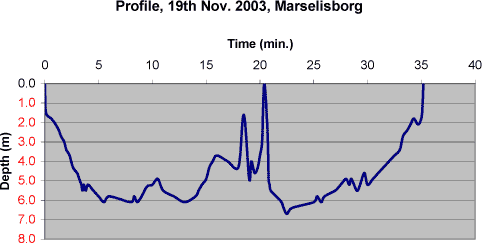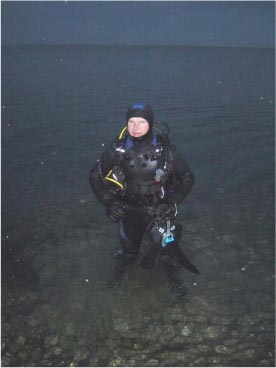|
| Front page | | Contents | | Previous | | Next |
Mapping and release of chemical substances from products made of chloroprene
6 ”Real life” exposure test
6.1 Test description
In order to be able to assess the exposure in "real life" of potential migrants from consumer products made of chloroprene, a full-scale test with an experienced sport diver was carried out to complete the
migration studies. The diving test was carried out near Marselisborg marina in Aarhus where the water is 6-7m deep near the shore. The diver dived twice on Wednesday, 19th November 2003. The
conditions for one of the dives appear from the graph. The temperature of the sea water was 8°C and the temperature of the water drained from the suit was 18 – 20°C.

After the two-dive phase (65 minutes in total) and a break on shore (90 minutes), the dive suit was emptied of water on site by drawing it off from the sleeves and legs into a clean beaker. The water was
then poured into a clean glass with a screw cap. The water from the dive suit was then to run off overnight so a clean beaker was placed below each of the legs of the suit. The water that ran off was
combined with the water drawn off on site. The total amount of water was 155ml. A sample was taken of the sea water as reference for the migration analysis.
Water emptied of the socks on the diving site was so muddy that it was decided to measure only for the nickel content in this water (the socks were not new).

Photo 6-1 Surfacing after the first dive.
6.2 Results from the migration investigation
The water samples from the "real life" experiment were analysed for nickel release and for release of organic substances. The results of the analyses are listed below in Table 6.1.
Converted to skin area based on 20.000 cm² one can calculate the following concentrations of migrating chemical substances per cm² skin area: Isophoron 0,003 ng/cm², N,N-dibutylformamid 0,26
ng/cm², N,N-diethylthiourea 0,28 ng/cm² and nickel 0,74 ng/cm².
If one compares the migration tests carried out in the laboratory to artificial seawater one realises that only in the “real life” experiment migration of N,N-diethylthiourea is detected. Further one realise that the
measured migration levels of chemical substances calculated by area unit are less than 1 ng/cm² for all substances in the “real life” experiment. For two substances i.e. isophoron and N,N-dibutylformamide
the results from the laboratory exposures were 11 ng/cm² and 20 ng/cm². This results are much higher and underline the importance of carriing out migration experiments as close to actual exposure
conditions as possible.
Table 6.1 Results of the analysis of liquid from the dive suit after the diving test
| Chemical compound |
CAS no. |
No. 8 Dive suit, diving test |
| µg/ml |
µg, total |
| Aldehydes and ketones |
|
|
|
| 3,5,5-Trimethyl-2-cyclohexen-1-one (isophorone) |
78-59-1 |
0.039 |
6.045 |
| Aromatic hydrocarbons |
|
|
|
| Toluene |
108-88-3 |
|
|
| Aromatic amines and phenols |
|
|
|
| Phenol |
108-95-2 |
|
|
| Formamide derivatives |
|
|
|
| N,N-Dibutyl formamide |
761-65-9 |
0.33 |
51.15 |
| Urea derivatives |
|
|
|
| N,N-diethylthiourea |
105-55-5 |
0.36 |
55.8 |
| Other |
|
|
|
| N-Butylbenzene sulphonamide |
3622-84-2 |
|
|
| Metals |
|
|
|
| Nickel |
7440-02-0 |
0.095 |
14.7 |
| Front page | | Contents | | Previous | | Next | | Top |
Version 1.0 September 2005, © Danish Environmental Protection Agency
|